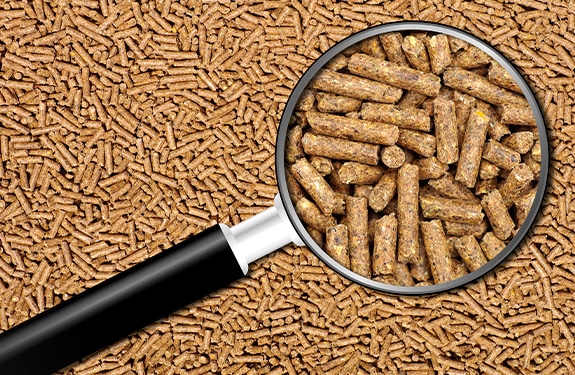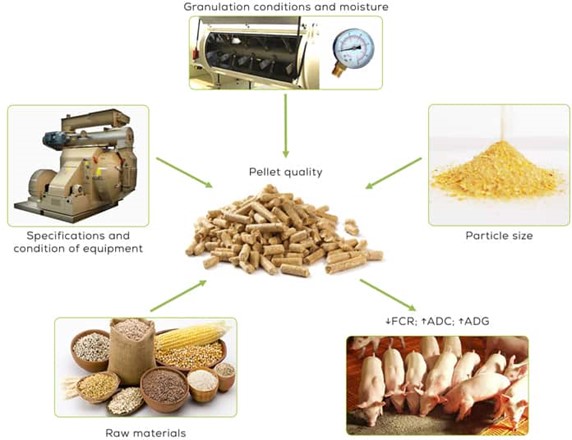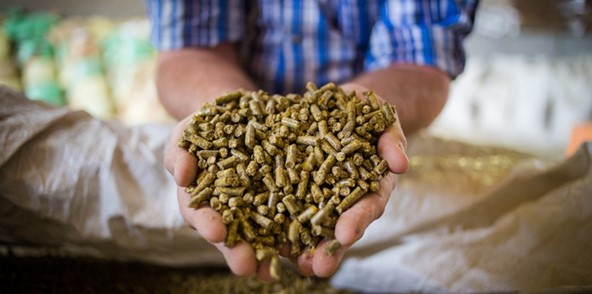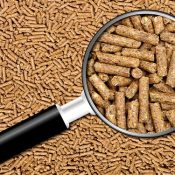Improving pellet quality, the key to good performance

Improving pellet quality, the key to good performance
Improving pellet quality, the key to good performance
Néstor Serra Gómez-Nicolau Technical ManagerAdiveter S.L.
Alicia Baz Montero Marketing Manager Adiveter S.L.
The pelleted feed manufacturing process has undergone a significant evolution in recent decades due to the demand for higher standards of physical quality, nutritional value and microbiological hygiene, as well as greater flexibility in the incorporation of new and varied raw materials. The digital age in feed industry is becoming increasingly important, KPI measurement and monitoring can be done in real time. More monitoring in real time of the production process allows better asset utilization, better inventory management and better production and quality assurance.
WHAT IS PELLETING?
Pelleting improves the characteristics of balanced feeds due to the effect of cooking on the digestibility of starches and nutrient absorption: that is, it increases the digestibility of the nutrients and so improves the feed conversion ratio and production index of the farm unit.
By subjecting starches to heat and moisture, water absorption takes place and the starch granule loses its crystalline structure, a process that is catalyzed by a rapid increase in temperature. This causes the starch granule to burst, producing a gelatinous mass: that is, gelatinization of the starches occurs.
In addition to the gelatinization of starches, the use of heat also leads to an increase in the absorption of nutrients and a reduction in any pathogens that could be contaminating the feed, while eliminating anti-nutritional factors and allowing for the incorporation of a higher range and quality of difficult to granulate raw materials. The absorption of moisture also increases the lubrication, softening and cooking of the feed.
The often cited inconveniences of pelleted feed include the need for specialized machinery (conditioners, granulators and chillers), and a lengthier and apparently more costly manufacturing process.
This increase in costs is attributable to:
• amortization of investments in machinery,
• higher energy consumption,
• maintenance of equipment,
• and the loss of raw materials during the manufacturing process (loss of moisture during storage, grinding, granulation, etc).
This can be mitigated by the use of real time on-line humidity technology, to ensure constant moisture levels in the mixer and obtain the target humidity in each batch, thus obtaining pellets of sufficiently high quality to withstand the whole manufacturing and transportation process, up to arrival at the final destination – the feeding trough on the farm -, reducing the formation of fines and avoiding unnecessary losses.
PELLET QUALITY AS A KEY PERFORMANCE INDICATOR
The quality of the pellet is important not only for commercial reasons but also for its effect on the production index, which is the basis for good livestock performance.
Quality here is a combination of several factors, namely: durability, hardness and appearance, – appearance includes colour, surface texture, uniformity of size, percentage of fines and palatability.
Some of these factors are subjective, but others are objective (measurable) and should be taken into account:
Durability:
This is probably the most important factor to assess, and refers to the ability of the pellet to withstand transport and handling without breaking, and with the minimum possible percentage of fines.
It is calculated by subjecting the feed to a Standardized Durability Test and is expressed by means of the Pellet Durability Index (PDI), which is the percentage of the mass of the pellets remaining intact with respect to the total mass of pellets.
Uniform Size: The variability of pellet size (length and diameter) not only affects the appearance of the feed but also the durability or consumption.
Percentage of fines: This should be kept to the minimum, assuming adequate sieving of the pellets has been carried out.
Hardness: This refers to the weight (in kg) that the pellet is able to withstand without breaking. It has to be sufficient to withstand storage and transportation to the farm. Hardness and durability are not always correlated.
It should be borne in mind that there are numerous factors that affect the quality of the pellet: (Figure 1) raw materials, particle size, conditioning, granulator matrix, cooling and drying, condition of equipment, etc.
Therefore, one of the most important factors that determine pellet quality is the moisture level in the conditioning process, which must sufficient to guarantee thorough cooking and most important, good gelatinization of the starches.
FACTORS THAT INFLUENCE PELLET QUALITY
1. Raw materials:The cereal grain used (corn vs wheat) and its inclusion percentage will influence quality since, depending on the origin of the starch, the target temperatures needed to achieve gelatinization will be different (see Table 1).
Another factor is the inclusion of fats (more than 1%), regardless of the source (animal or vegetable), which can greatly damage the pellet quality.
2. Particle size: The size of the particle is another factor that affects quality. As a general rule, the finer the particle is ground, the higher the quality of the pellet obtained as the particles are more exposed to the conditioning process and the pellet obtained is more compacted.
3. State of the equipment: The state of the manufacturing equipment also determines the quality of the pellet. This is so obvious that it is often not taken into account as much as it should be in the daily routine of the feed mill.
The wear and tear of the hammers, the dies, the rollers, etc., or the incorrect positioning or orientation of the blades or steam injection valves, are all detrimental to the quality of the pellet.

Figure 1. Factors affecting pellet quality
4. The granulation process:Good granulation is essential, because it directly determines:
• Durability
• Amount of fines
• Efficiency of the pelletizing process (amount produced and energy consumption)
A conditioning temperature greater than 80-85°C is the most suitable for the gelatinization of starch.
The die hole diameter can also influence the PDI (Miladinovic & Svihus)
The steam used, after leaving the boiler and before entering the conditioner, must be regulated so that the quantity, quality and energy are adequate to achieve good results.
Managing steam quality, together with moisture content and retention time in the conditioner, is critical to the successful granulation process. The steam extracts the essential oils in the cereal grains and lubricates the feed through the matrix, reducing friction and wear of the machinery and increasing pelletizer production rates (tonnes/hour).
HOW DOES INDUSTRY 4.0 TRANSFORM ANIMAL AND FEED INDUSTRY?
The implementation of innovative technology is lately increasing and the animal industry is no stranger to this reality, becoming decisive for its future development. With an increasingly demanding market, where feed represents between 65 and 80% of production costs and restrictions on the use of antimicrobials in the diet are increasing, the adoption of technology is a trend that also applies to the manufacture of feed. Producing a quality feed with high nutritional value is no longer an option, but a fundamental requirement to remain competitive. This leads us to a concept developed in recent years, known as industry 4.0, where new technologies are implemented to feed production integrating all the processes involved in feed manufacturing in an automated and customizable way (Zambon et al., 2019).
FEED ANALYSIS BY NIR TECHNOLOGY
A clear example is the incorporation by major production systems of near-infrared reflectance spectroscopy (NIRS) imaging technology. This technology makes it possible to quickly and reliably determine the nutritional content of different types of cereals used in animal feed and to formulate more precisely, generating a better utilization of nutrients and thus decreasing the carbon footprint. A study conducted by Brown et al. (2020) at the University of Alberta analyzed the costs and economic return of incorporating NIRS technology in swine farming and concluded that it generates an average annual savings of up to USD 4 per pig, confirming the feasibility of its implementation in pig farms. Likewise, Dr. Jansman, senior researcher at Wageningen Livestock Research, explains how through different processing technologies, it is possible to improve the nutritional value of raw materials, increasing the efficiency of nutrient utilization by animals and decreasing the environmental impact (WUR, 2020).
DATA COLLECTION BY SENSORS IN FEED INDUSTRY
In relation to feed processing, a great opportunity is the implementation of sensors that allow real-time monitoring of the feed milling, mixing and pelleting process. The quality of processing has a direct impact on consumption, daily weight gain and feed conversion (Lewis et al., 2015) and by monitoring variables such as particle size, dispersion, moisture and temperature in real time, we can ensure that the feed meets our production standards (Behnke, 2001). The implementation of 4.0 technology applied to feed mills will allow us to have a big data infrastructure capable of collecting and processing a large amount of data from one or several feed plants and obtain different KPIs in real time in each of the feed production processes, optimizing decision making and improving both the production rate and the quality of the finished product (Van Der Poel et al., 2020). Another important advantage, in relation to data management, is that it allows more accurate assessments of overall costs during feed production; this translates to greater savings in terms of energy and water resources, as well as a lower carbon footprint (Piñeiro et al., 2019). Technologies such as artificial intelligence and the internet of things (IoT) are already applied in other industries such as human nutrition, and will be added to the industrial revolution in animal farming to digitize and monitor the different processes (Raba et al., 2020). In summary, Industry 4.0 will increase the competitiveness of feed mills, and facilitate continuous alignment with the demands of the sector. Its implementation will require collaboration between scientists, machine experts, feed manufacturing technologists and nutritionists, using advanced data analytics for process optimization.

SMART TECHNOLOGY TO MAXIMIZE PELLET PROFITABILITY
In addition to controlling and modifying everything relating to the above variables correctly, to optimize the pelletizing process, on-line technologies such as Pellet Plus On-Line and Cooler Plus On-Line, developed by Adiveter, can be used to continuously measure KPI levels in the mixer and cooler and adjust in real time the dose of hydrating solution (water with a surfactant premixture: Re-Hydra Pro®) necessary to optimize the process and reach the following objectives:
• Higher yields: increase in production (↑tonnes feed/hour) and decrease in energy consumption (↑kWh/t) Higher pellet quality (↑PDI)• Improved digestibility, etc.
More attention should be paid in the day-to-day routine to controlling the multiple factors that affect pellet quality, and the all too common mistake of trying to solve the problems of quality by using a high compression matrix or by the use of binders should be avoided, as all this will result in higher production costs and, sometimes, doubtful efficiency and quality.
About Néstor Serra Gómez-Nicolau, DVMDegree in Veterinary Science by “Universidad Autónoma de Barcelona”, in Spain. I joined Adiveter in 2013 to give technical support to customers and distributors worldwide in order to help feed producers and farmers to ensure feed safety and animal health.
About Alicia Baz Montero, DVMDegree in Veterinary Science by “Universidad Autónoma de Barcelona” and MBA pharmaceutical and biotechnology industry, in Spain. I develop and execute marketing strategies to meet Adiveter customer needs, running research programs and market insights for brands and create promotional material and marketing campaigns for market development.


